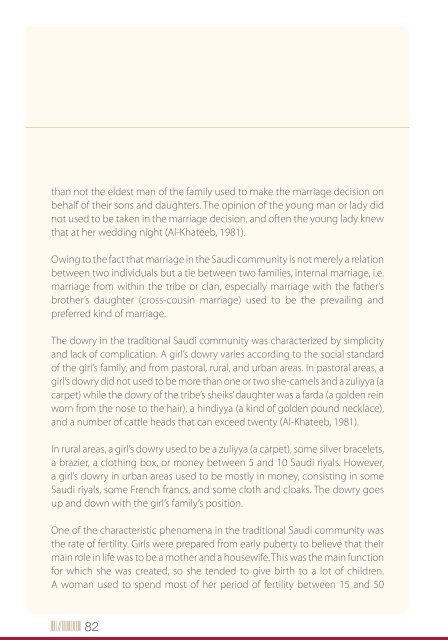General Supervisor
General Supervisor
General Supervisor
You also want an ePaper? Increase the reach of your titles
YUMPU automatically turns print PDFs into web optimized ePapers that Google loves.
than not the eldest man of the family used to make the marriage decision on<br />
behalf of their sons and daughters. The opinion of the young man or lady did<br />
not used to be taken in the marriage decision, and often the young lady knew<br />
that at her wedding night (Al-Khateeb, 1981).<br />
Owing to the fact that marriage in the Saudi community is not merely a relation<br />
between two individuals but a tie between two families, internal marriage, i.e.<br />
marriage from within the tribe or clan, especially marriage with the father’s<br />
brother’s daughter (cross-cousin marriage) used to be the prevailing and<br />
preferred kind of marriage.<br />
The dowry in the traditional Saudi community was characterized by simplicity<br />
and lack of complication. A girl’s dowry varies according to the social standard<br />
of the girl’s family, and from pastoral, rural, and urban areas. In pastoral areas, a<br />
girl’s dowry did not used to be more than one or two she-camels and a zuliyya (a<br />
carpet) while the dowry of the tribe’s sheiks’ daughter was a farda (a golden rein<br />
worn from the nose to the hair), a hindiyya (a kind of golden pound necklace),<br />
and a number of cattle heads that can exceed twenty (Al-Khateeb, 1981).<br />
In rural areas, a girl’s dowry used to be a zuliyya (a carpet), some silver bracelets,<br />
a brazier, a clothing box, or money between 5 and 10 Saudi riyals. However,<br />
a girl’s dowry in urban areas used to be mostly in money, consisting in some<br />
Saudi riyals, some French francs, and some cloth and cloaks. The dowry goes<br />
up and down with the girl’s family’s position.<br />
One of the characteristic phenomena in the traditional Saudi community was<br />
the rate of fertility. Girls were prepared from early puberty to believe that their<br />
main role in life was to be a mother and a housewife. This was the main function<br />
for which she was created, so she tended to give birth to a lot of children.<br />
A woman used to spend most of her period of fertility between 15 and 50<br />
82<br />
continuously giving birth to children, which meant that she normally would<br />
give birth to from 10 to 15 children. Breast feeding used to be woman’s only<br />
natural means of contraception. In spite of the high rate of birth, child mortality<br />
rate was high. Women used to give birth to 10 or 12 children, but only 3 or<br />
4 children survived. In the traditional Saudi community, the rate of abortion<br />
used to be very high for many reasons: the many jobs that women used to be<br />
overburdened with, shortage of food, lack of rest between one pregnancy and<br />
another, and decreasing medical services. Unfortunately, there are no statistics<br />
to evidence this. However, most of the informants that I met with from the<br />
pastoral, rural, and urban communities confirm this (Al-Khateeb, 1997).<br />
The Saudi community theoretically believes that the main role of the woman is<br />
reduced to being a mother and a housewife. In reality, poverty and starvation<br />
prevailing in the traditional Saudi community before the advent of oil, pushed<br />
both woman and man to work hard together to provide for the needs of their<br />
family. In all of the pastoral, rural, and urban communities, woman used to<br />
permanently work from daybreak to sunset to provide for the needs of her<br />
family (Al-Khateeb, 1997).<br />
Factors of change in the Saudi community<br />
The Kingdom witnessed several factors of change, which can be classified<br />
under two main factors: internal and external.<br />
First: Internal factors<br />
The Kingdom witnessed several factors of internal change, namely the political<br />
and economic factors, which impacted the social structure in the Kingdom.<br />
1. Political factor<br />
The political factor, which consisted in the unification of all the regions in<br />
the Arabian Peninsula under the same government of the Kingdom of Saudi<br />
83


